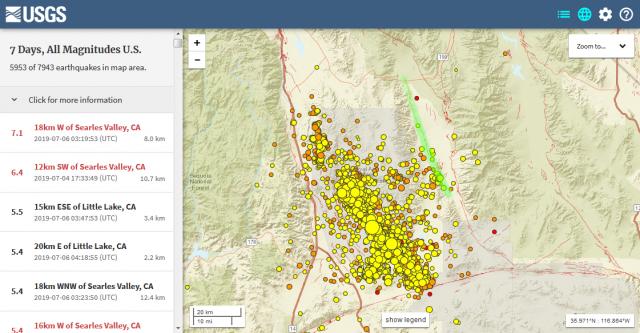07-09-2019, 06:33 AM
As I alluded in my post re the 7.1 quake, there is a cluster of quakes stretching east of the main aftershocks, with a bit of clustering on the Ash Hills fault.
Below is a map of the quakes from the USGS with largest listed first (and on top). I've also highlighted the Ash Hills fault (highlighted in green).
In doing a quick google for info on this fault, I found a recent (2016) study on the SCEC website.
Late Holocene rupture history of the Ash Hill fault, Eastern California Shear Zone
Using the most conservative numbers of only .5mm/yr slip rate and only 500 years since the last event, that's still 2.5m of accumulated strain, which is more than the youngest event.
I have yet to see a coulomb stress map of the 7.1, but if I understand how stress distributes, there should if anything be a reduction of stress in this direction from this right lateral event.
Just our usual back-of-the-envelope wild guess, but could the Ash Hill fault be next?
Brian

Below is a map of the quakes from the USGS with largest listed first (and on top). I've also highlighted the Ash Hills fault (highlighted in green).
In doing a quick google for info on this fault, I found a recent (2016) study on the SCEC website.
Late Holocene rupture history of the Ash Hill fault, Eastern California Shear Zone
Quote:At one site, a single continuous surface rupture laterally displaces three generations of alluvium, with 1-1.5m, 1.6-2.6m, and 2.7-4.9m of offset in the youngest, intermediate, and oldest surfaces. Ages of faulted surfaces, currently determined using a locally calibrated soil chronosequence, suggest that the most recent rupture occurred within the past ~500-800 years, and that the previous two ruptures occurred since 2-4 ka. When combined with displacement magnitudes, these data indicate late Holocene slip rates on the order of 0.5–1 mm/yr...
Using the most conservative numbers of only .5mm/yr slip rate and only 500 years since the last event, that's still 2.5m of accumulated strain, which is more than the youngest event.
I have yet to see a coulomb stress map of the 7.1, but if I understand how stress distributes, there should if anything be a reduction of stress in this direction from this right lateral event.
Just our usual back-of-the-envelope wild guess, but could the Ash Hill fault be next?
Brian
 Logout
Logout  Portal
Portal  Forum
Forum Search
Search Members
Members Help
Help 
